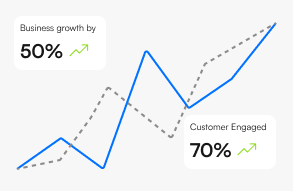Chatbot vs. Conversational AI

Rajesh Bhattacharjee
November 27, 2023
5 min

Table of Contents
Have you ever chatted with a customer service bot on a website and wondered how it understands what you’re saying? This blog will explore two technologies behind these interactions: chatbots and conversational AI. Understanding the difference between chatbots and conversational AI is crucial for businesses looking to improve customer service, boost engagement, and streamline operations. We’ll dive into what each technology offers and how they differ, helping you make the best choice for your needs.
Understanding Chatbots
What Are Chatbots?
Chatbots are virtual assistants you can chat with on websites or messaging apps. They’re programmed to respond to specific keywords or phrases with pre-set answers. Think of them as automated responders that help with basic customer queries.
The Evolution of Chatbots
Chatbots have been around for a while. They started as simple programs that could only answer particular questions and have evolved into more sophisticated systems. However, traditional ai chatbot builder still rely heavily on scripted responses and can need help with complex or unexpected questions.
How Do Chatbots Work?
A basic chatbot scans your words and looks for keywords or phrases it recognizes. Once it finds a match, it responds with a pre-programmed answer. These chatbots are great for answering frequently asked questions but may need help understanding things.
Chatbots in Different Industries
From retail to banking, chatbots are everywhere. They help businesses handle simple tasks like taking orders, answering basic questions, and providing information about products or services. This frees up human employees to focus on more complex tasks.
Exploring Conversational AI
What is Conversational AI?
Conversational AI is a step up from traditional chatbots. It uses more advanced technology like natural language processing (NLP) and machine learning to understand and respond to human language more naturally. This allows for more fluid and realistic conversations.
Advancements Leading to Conversational AI
The development of conversational AI has been possible thanks to giant leaps in AI technology. NLP and machine learning improvements mean these systems can learn from past conversations, understand the context better, and handle a broader range of queries.
How Does Conversational AI Work?
Conversational AI analyzes the intent and context of a user’s words, not just keywords. This allows it to have more natural and helpful conversations. It gets better over time, too, learning from each interaction to improve its responses.
Uses and Examples of Conversational AI
Conversational AI is used in customer service to handle more complex queries, in virtual assistants like Siri and Alexa, and even in healthcare for patient support. Its ability to understand and respond more like a human makes it valuable in any situation where realistic interaction is essential.
Critical Differences Between Chatbots and Conversational AI
Understanding the critical differences between chatbots and conversational AI is essential for businesses looking to enhance customer interaction and support. While both technologies can automate conversations, their capabilities and the level of sophistication vary greatly.
Intelligence and Capabilities
Chatbots are like basic scripts, responding only to specific commands or keywords. They’re great for simple, straightforward tasks but need help to handle complex conversations. Conversational AI, on the other hand, uses advanced algorithms to understand and respond to a wide range of queries more like a human would.
Understanding Context and Handling Complex Queries
The biggest strength of conversational AI is its ability to understand context. Compared to chatbots, which can get confused by questions that don’t match their script, conversational AI can follow a conversation, remember past interactions, and handle more complicated questions more effectively.
User Experience and Engagement
Regarding user experience, conversational AI provides a more engaging and fluid interaction. Users can chat more naturally without having to figure out the exact keywords or phrases the system understands. This leads to a more satisfying and human-like experience.
Certainly! Here’s the expansion of the remaining sections of the blog post on “Chatbot vs. Conversational AI,” using simple language and focusing on the “chatbot vs conversational AI” theme:
Advantages and Limitations
Advantages of Using Chatbots in Business Operations
Chatbots are like helpful assistants who never sleep. They are perfect for answering common questions, taking orders, or booking appointments 24/7. This improves customer service and saves time and resources for businesses.
Advantages of Conversational AI Over Traditional Chatbots
Conversational AI takes customer interaction to the next level. It understands and responds in a more human-like way, making customers feel more heard and understood. This can lead to better customer satisfaction and loyalty.
Limitations and Challenges
However, both technologies have their limitations. Standard chatbots can’t handle complex queries well, and conversational AI systems require more resources and data to function effectively. Plus, making these systems understand different languages, accents, and slang is always challenging.
Choosing the Right Solution for Your Business
Factors to Consider
When deciding between a chatbot and conversational AI, consider your business needs. A chatbot might be enough if you need to handle simple tasks like FAQs. But conversational AI might be the way to go if you’re looking to provide in-depth customer support or create a more engaging user experience.
Cost and Complexity
Also, think about the cost and complexity. Chatbots are generally cheaper and easier to implement, while conversational AI systems can be more expensive and require more technical know-how.
Technical Infrastructure Required
Make sure you have the proper infrastructure for conversational AI. This includes data storage and processing capabilities and the right team to manage and train the AI system.
Future Trends and Developments
Evolving Technologies
The future of chatbots and conversational AI looks exciting. We’re likely to see even more advanced AI that can understand and respond in increasingly human-like ways. This could transform customer service and how we interact with technology in our everyday lives.
Changing Business Processes
As these technologies evolve, they will also change the way businesses operate. We can expect more automation, more personalized customer experiences, and even new business models based on AI-driven interactions.
Conclusion
Whether a simple chatbot or a sophisticated conversational AI, these technologies are reshaping how businesses interact with their customers. Understanding the differences between chatbot and conversational AI is crucial for making the right choice for your business needs.
Remember, it’s not just about the technology; it’s about creating better, more efficient, and more enjoyable customer experiences. The right choice can give you a significant edge in today’s competitive market.

Grow Your Business with AI Chatbots
- Automate tasks
- Engage customers 24/7
- Boost conversions